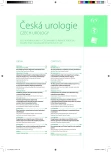Predictive factors for prostate cancer detection using saturation prostate biopsy
Authors:
Otakar Čapoun; Roman Sobotka; Petr Macek; Tomáš Hanuš
Authors place of work:
Urologická klinika 1. LF UK a VFN, Praha
Published in the journal:
Ces Urol 2012; 16(3): 163-170
Category:
Původní práce
Summary
Aim:
The aim of this study was to identify parameters predictive of prostate cancer (PC) in saturation prostate biopsy (SPB) and its comparison to outcomes of prostate re-biopsy using the standard technique.
Methods:
A total of 108 patients underwent SPB at the Dpt. of Urology, General Teaching Hospital, Prague between September 2010 and January 2012. Prior to SPB each patient underwent at least one standard biopsy with negative or suspicious result. In addition following parameters were recorded in each patient: Total and free prostate-specific antigen (PSA) value, prostate size, PSA density, number of cores, total length of cores, histological result, number of positive cores, length of PC in millimeters, Gleason score (GS), number of previous biopsies and a total number of cores taken in standard biopsies. The results of SPB were compared to a control group of patients with identical initial parameters that had undergone re-biopsy using the standard prostate biopsy. Relationships between variables were assessed using Spearman’s rank correlation coefficient. Control group was selected using the Wilcoxon test. Comparison between the SPB and standard biopsy groups, as well as the effect of baseline parameters on detection of PC was done using the chi-square test.
Results:
Median age was 64 years (50–83), mean PSA level was 10.4 ng/ml (2.64–39.7), mean PSA density was 0.229 (0.043–1.329). T1c classification was recorded in 65.1% of cases. Positive digital rectal exam (DRE) and ultrasonography finding was present in 21.7% and 28.3% of patients, respectively. Median prostate size was 52 g (17–116). A total of 5 complications was recorded; two septic reactions and three cases of enterorrhagia. Prostate cancer was detected in a total of 35 patients (33%) in 1–8 biopsy cores. Most cases were classified as Gleason score 6 (3 + 3). Only five patients with PC entered an active surveillance protocol. Prostate cancer was found in 22% of cases from the control group of 98 standard biopsies (p = 0.0928). The ratio of free to total PSA (p = 0.0302) and positive DRE (p = 0.0125) were statistically significant in predicting PC detection in SPB.
Conclusion:
Saturation prostate biopsy is a safe method of PC detection. Clinical data showed limited potential of predicting the result of SPB. SPB has a significantly higher PC detection rate compared to standard biopsy.
Key words:
prostate cancer, prostate biopsy, transrectal sonography, diagnostics.
Zdroje
1. Dušek L, Mužík J, Kubásek M, et al. Epidemiologie zhoubných nádorů v České republice [online]. Masarykova univerzita 2005 [cit. 2012-2-11]. Dostupný z: http://www.svod.cz. Verze 7.0 [2007].
2. Heidenreich A, Bellmunt J, Bolla M et al. EAU guidelines on prostate cancer. Part 1: screening, diagnosis, and treatment of clinically localised disease. Eur Urol 2011; 59(1): 61–71.
3. Shariat SF, Roehborn CG. Using biopsy to detect prostate cancer. Rev Urol 2008; 10: 262–280.
4. Kaplan SA, Ghafar MA, Volpe MA, et al. PSA response to finasteride challenge in men with a serum PSA greater than 4 ng/ml and previous negative prostate biopsy: preliminary study. Urology 2002; 60(3): 464–468.
5. Ashley RA, Inman BA, Routh JC, et al. Reassessing the diagnostic yield of saturation biopsy of the prostate. Eur Urol 2008; 53(5): 976–981.
6. van der Kwast TH, Lopes C, Santonja C, et al. Guidelines for processing and reporting of prostatic needle biopsies. J Clin Pathol 2003; 56(5): 336–340.
7. Hong YM, Lai FC, Chon CH, et al. Impact of prior biopsy scheme on pathologic features of cancers detected on repeat biopsies. Urol Oncol 2004; 22: 7–10.
8. Djavan B, Fong YK, Ravery V, et al. Are repeat biopsies required in men with PSA levels < or = 4 ng/ml? A Multi-institutional Prospective European Study. Eur Urol 2005; 47: 38–44.
9. Sobotka R, Čapoun O, Pešl M, et al. Ověření prediktivní schopnosti jednotlivých parametrů pro záchyt karcinomu prostaty v systematické biopsii prostaty. Czech Urol 2011; 15(Suppl 2): 16–88.
10. Zaytoun OM, Jones JS. Prostate cancer detection after a negative prostate biopsy: lessons learnt in the Cleveland Clinic experience. Int J Urol 2011; 18(8): 557–568.
11. Epstein J, Herawi M. Prostate needle biopsies containing prostatic intraepithelial neoplasia or atypical foci suspicious for carcinoma: implications for patient care. J Urol 2006; 175: 820–834.
Štítky
Dětská urologie Nefrologie UrologieČlánek vyšel v časopise
Česká urologie

2012 Číslo 3
- Kam se posunula léčba SLE v roce 2024 – aktuální klinická doporučení
- Význam monitorování hladiny anti-Xa u pacientů užívajících profylaktické dávky enoxaparinu − série kazuistik
- Prevence opakovaných infekcí močových cest s využitím přípravku Uro-Vaxom
- Vysoká hladina PSA a její rychlý nárůst jsou nepříznivými prognostickými faktory u karcinomu prostaty
Nejčtenější v tomto čísle
- Prediktivní parametry záchytu karcinomu prostaty v saturační biopsii prostaty
- Role vložkových testů v diagnostice inkontinence moči
- Germinální tumor varlete u nespolupracujícího pacienta
- První zkušenosti s novým jednostranně ostnatým stehem V-Loc při laparoskopické radikální prostatektomii
